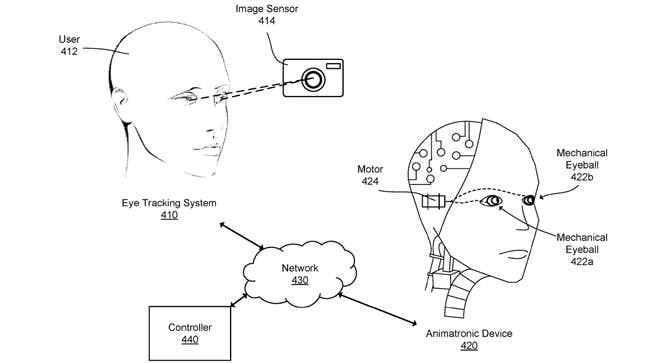
It’s well known at this point that the company previously known as Facebook is spending billions of dollars in resources to transport as many of its users as possible out of the real world and plop them into an avatar-filled metaverse. What’s less talked about though are the ways Meta is simultaneously adding quintessentially human attributes to machines. The company is at it again, this time with designs for a human-like mechanical eyeball according to a patent first discovered by Insider.
The filing for the “mechanical eyeball 100,” granted back in December, claims the metal orb is, “a robotic eye designed to resemble a [human] eye,” with two rotational axes that intersect at a center point. The design’s descriptions seem pretty sophisticated too, with parts meant to mimic the sclera, retina, and cornea of a human eye as well as the pupil and iris.

But what’s an eye without a head? Meta thought that through too—according to the patent, the eye is designed to “mate” with an animatronic robot head in an effort to make the eye, “appear authentic to an observer.”
The eyeball would be equipped with sensors to help it “see,” an ability its creators say could be trained and improved using machine learning—potentially based on eye-tracking data movement of human users—which could then be mapped onto the mechanical eyeball. For this, imagine a human working through a sort of CAPTCHA test but for a robotic eye.
In a statement sent to Gizmodo, a Meta spokesperson said the company doesn’t comment on the specific coverage of its patents or reasons for filing them. The spokesperson went on to say patents, in general, “don’t necessarily cover the technology used in our products and services.”
Meta isn’t just trying to create a deep-gazing mechanical monster; the mechanical eye could serve more practical applications as well. For example, the eyeball wouldn’t just be trained on human eye tacking but could also conversely be used as a tool to more accurately track human eye movement. As Insider notes, this type of technology could potentially speed up the development of the company’s AR and VR applications which rely heavily on eye-tracking. Those, in turn, are instrumental for the company’s metaverse ambitions.
This isn’t the first time Meta has flirted with adding human characteristics to robots. Back in November, Meta announced it had partnered with Carnegie Mellon University to create a lightweight, tactile-sensing robot “skin” that could imbue robots with a sense of touch. That new flood of environmental touch data could then supposedly be used to create, “realistic virtual objects and physical interactions in the metaverse,” founder Mark Zuckerberg said in a Facebook post.
The mechanical eyeball and synthetic skin explorations are part of wider robotics experimentations within Meta’s AI division first made public back in 2019.